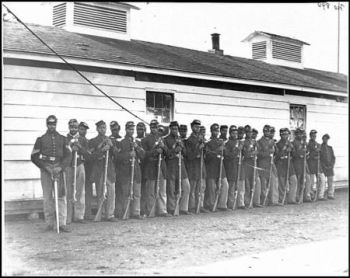 Included in the United States’ battle preparations for the coming spring engagements is the use of large numbers of black soldiers, former slaves who are ready and willing to fight for the freedom of their families and friends yet enslaved in the Confederate States.
Included in the United States’ battle preparations for the coming spring engagements is the use of large numbers of black soldiers, former slaves who are ready and willing to fight for the freedom of their families and friends yet enslaved in the Confederate States.
A number of “colored regiments” proved their mettle during the battles of the past year, not the least of which was the 54th Massachusetts Regiment which fought valiantly and against overwhelming odds in the early days of the campaign against Charleston in the summer of 1863. Since that time, many other black regiments have demonstrated, in the eyes of a growing number of white officers and soldiers, that black soldiers are as capable as white soldiers.
Many white Union men, however, remain critical of the deficiencies they perceive in black soldiers. Racism certainly is partly responsible for their views, as is the fact that formerly enslaved blacks were typically prohibited from reading, writing and exercising any significant degree of free agency. In such circumstances, freedmen have a mountain to climb in terms of assimilating into Union army ranks.
Today Ira B. Reynolds of Wisconsin, having originally enlisted as a private in Company E, Third Regiment, Wisconsin Volunteer Infantry, becomes the Captain of Company I, 43rd United States Colored Infantry, mustering in at Camp William Penn, Philadelphia.
Apparently not having had much contact with black soldiers previously, Reynolds later writes an account of “comparisons” between white and black soldiers, based on his experiences first as a private in a white regiment then as the captain of a black regiment. The first lesson he learns regarding black soldiers involves a colored Baptist minister.
I found Company I to be composed of about 100 colored men, of all ages, sizes, and can truly say, of all shades of color, from jet black to a pale white and nearly all of them directly from some slave plantation in the south. They were physically a good looking lot of men and when I formed them in line and requested all who could read and write to step forward, not enough were found to make the necessary non-commissioned officers. To show more plainly the character and condition of the men whom I had to drill and organize, I will give a brief history of one of them. The next day a man came to me and said: “Captain, John Anderson, one of your men, can read and write, but he says he was afraid to tell you.”
After sending for John Anderson he told me this story: He said that: “He had always been a slave on a plantation in Kentucky, that his master had given orders to cut off the first finger of every slave that learned to write. His master ‘s wife had taught him to write unbeknown to her husband, and that he had been a Baptist preacher for twelve years, and he was afraid to tell me until I assured him that I would do him no harm.” I found some of the men had been freemen and had always lived at the north. They could read and write but they were the worst men I had to manage. I organized the company the best I could and commenced to teach them the duties of a soldier, and I have this to say, that I never saw a class of men that would imitate your every movement and make them their own faster and more perfectly than they could. I soon found that their imitation was wonderful, and I had to be very careful that everything I wanted them to do was done just right, and I soon had a splendid company for dress parade. They soon learned the manual of arms to perfection.
As is the case with white soldiers, in the months ahead Reynolds finds some black soldiers more capable than others, some industrious and others frivolous, some responsible and others undependable.
Reflecting after the war, Reynolds summarizes his assessment of black soldiers compared to white soldiers:
I found that slaves under the command of good white officers made very good soldiers; but cannot say that they are as good in the field, under fire, as white troops are. It could not be expected. There was a wide difference between a young man brought up in the North, educated and free, a volunteer ready to lay down his life for his country, and a poor ignorant slave.
As difficult as is the task of turning “ignorant slaves” into soldiers during the two years that comprise the second half of the war, the job of educating and preparing freedmen for making a living in the post-war world proves immensely more difficult. Southern whites by and large are determined to not allow blacks equal freedom, while the resolve of the North in ensuring the equality of blacks proves far too shallow.
Source: Ira B. Reynolds, “White and Colored Troops in the United States Army–A Comparison,” in Civil War Voices (link)


